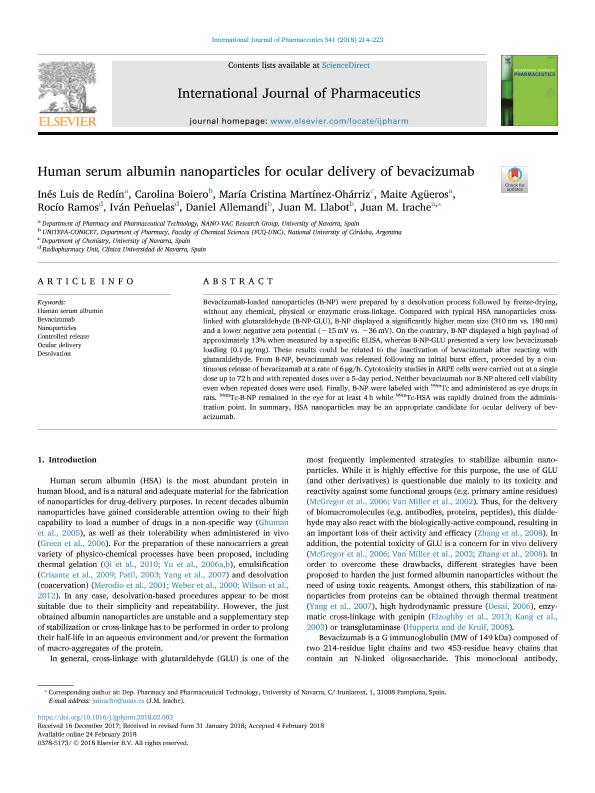Artículo
Human serum albumin nanoparticles for ocular delivery of bevacizumab
Luis de Redín, Inés; Boiero, Carolina ; Martínez-Ohárriz, María Cristina; Agüeros, Maite; Ramos, Rocío; Peñuelas, Iván; Allemandi, Daniel Alberto
; Martínez-Ohárriz, María Cristina; Agüeros, Maite; Ramos, Rocío; Peñuelas, Iván; Allemandi, Daniel Alberto ; Llabot, Juan Manuel
; Llabot, Juan Manuel ; Irache, Juan M.
; Irache, Juan M.
 ; Martínez-Ohárriz, María Cristina; Agüeros, Maite; Ramos, Rocío; Peñuelas, Iván; Allemandi, Daniel Alberto
; Martínez-Ohárriz, María Cristina; Agüeros, Maite; Ramos, Rocío; Peñuelas, Iván; Allemandi, Daniel Alberto ; Llabot, Juan Manuel
; Llabot, Juan Manuel ; Irache, Juan M.
; Irache, Juan M.
Fecha de publicación:
04/2018
Editorial:
Elsevier Science
Revista:
International Journal Of Pharmaceutics
ISSN:
0378-5173
Idioma:
Inglés
Tipo de recurso:
Artículo publicado
Clasificación temática:
Resumen
Bevacizumab-loaded nanoparticles (B-NP) were prepared by a desolvation process followed by freeze-drying, without any chemical, physical or enzymatic cross-linkage. Compared with typical HSA nanoparticles cross-linked with glutaraldehyde (B-NP-GLU), B-NP displayed a significantly higher mean size (310 nm vs. 180 nm) and a lower negative zeta potential (−15 mV vs. −36 mV). On the contrary, B-NP displayed a high payload of approximately 13% when measured by a specific ELISA, whereas B-NP-GLU presented a very low bevacizumab loading (0.1 μg/mg). These results could be related to the inactivation of bevacizumab after reacting with glutaraldehyde. From B-NP, bevacizumab was released following an initial burst effect, proceeded by a continuous release of bevacizumab at a rate of 6 μg/h. Cytotoxicity studies in ARPE cells were carried out at a single dose up to 72 h and with repeated doses over a 5-day period. Neither bevacizumab nor B-NP altered cell viability even when repeated doses were used. Finally, B-NP were labeled with 99mTc and administered as eye drops in rats. 99mTc-B-NP remained in the eye for at least 4 h while 99mTc-HSA was rapidly drained from the administration point. In summary, HSA nanoparticles may be an appropriate candidate for ocular delivery of bevacizumab.
Archivos asociados
Licencia
Identificadores
Colecciones
Articulos(UNITEFA)
Articulos de UNIDAD DE INVESTIGACION Y DESARROLLO EN TECNOLOGIA FARMACEUTICA
Articulos de UNIDAD DE INVESTIGACION Y DESARROLLO EN TECNOLOGIA FARMACEUTICA
Citación
Luis de Redín, Inés; Boiero, Carolina; Martínez-Ohárriz, María Cristina; Agüeros, Maite; Ramos, Rocío; et al.; Human serum albumin nanoparticles for ocular delivery of bevacizumab; Elsevier Science; International Journal Of Pharmaceutics; 541; 1-2; 4-2018; 214-223
Compartir
Altmétricas



